No matter where you turn in the world of watches, there is one name you will find around most corners. That name is Jean-Claude Biver. The more I learned about his career, and the more I listened to interviews with him, the more inspired I became. Few people have had such a marked impact on the watch world, and even fewer people speak with such an infectious passion and enthusiasm, whilst offering up unique and insightful ways of thinking.
It was my absolute honour to be able to speak with Mr. Biver and to ask about his career and thoughts on the future of the watch industry, and I would like to say a huge “thank you” to Mr. Biver for taking the time to speak with me!
In Conversation with Jean-Claude Biver
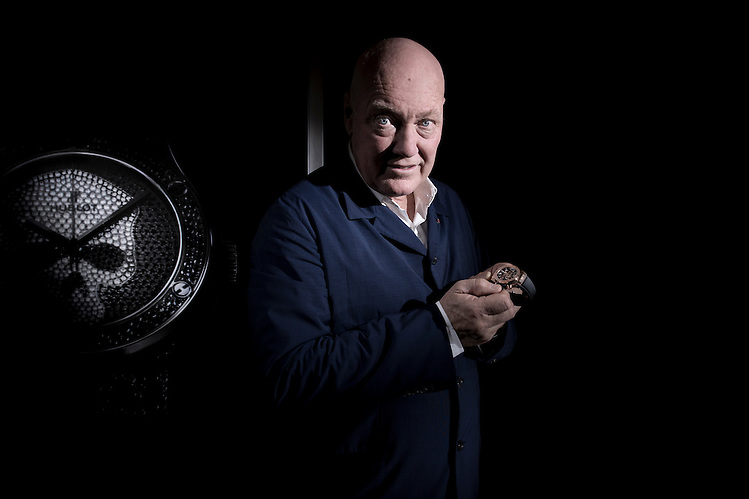
Jean-Claude Biver, photo © Fred Merz/Lundi13
WA: The years you spent at Audemars Piguet between 1975 and 1979 marked your first steps into the world of watches, and where you found your passion for watchmaking. You often talk about how you spent the first eight months solely learning the trade and the soul of watchmaking. Looking back, how formative and essential do you believe this first year was for you, with respect to the you had career which followed?
JCB: The 8 months that I spent with the watchmakers – they were the most important period of my professional life. Nothing has been more important than this first 8 or 9 months that I spent with the people. I didn’t spend it with customers, I didn’t spend it with retailers, I didn’t spend it with suppliers, I spent it with the people who with their fingers and their hands were making the most beautiful watches in the world.
That gave me an extremely deep passion and it gave me also the understanding of the mentality of the people. If you want to understand what these people are making, you must also understand their mentality, their culture, and I think nothing in my career has been more important. That is the start of my passion. If I wouldn’t have had the privilege to enter AP to get a job, and if I wouldn’t have had the chance – the enormous chance – to learn the art or to learn the people, through the people I have learned the art, and that is fundamental. Nothing has been more important in my professional life.
WA: I imagine it gives you a real sense of almost empathy of what goes into the watches and a real understanding of the soul.
JCB: Yes exactly.
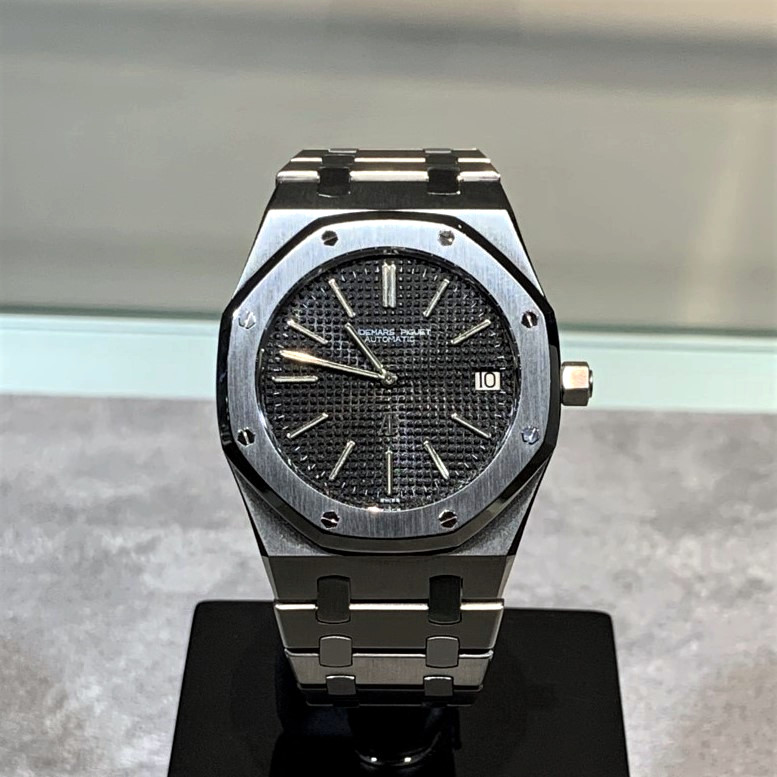
Early Audemars Piguet Royal Oak shown at “Jean-Claude Biver, A Retrospective: Share, Respect, Forgive” at Phillips, London, February 2020
WA: Last week, I listened to you talking about luck and risk. You spoke about the risks you had taken and the luck you have had throughout your career, and how working hard gives you more opportunity to meet luck. What were the biggest risks you took in your career?
JCB: My biggest risk is probably when I left AP. I was in love with the brand, I owe them everything, and nevertheless I was leaving. So, I was leaving somebody, or I was leaving a brand, that I was totally in love with. It’s very rare that when you are in love with somebody, or with an art, or with a job… why should you leave? Yes I was very impatient and did not want to wait too long to improve my responsibilities. When I left for Omega, I didn’t find much satisfaction because I could never leave AP. I was in another brand, and I also learned quite a lot from Omega, but AP was constantly in my heart.
I took a risk because I had a great relationship, I lived in the valley, my wife and everybody was there, I loved the region, I was running marathons, and I left! I don’t know why I left, except that I was very impatient! I know why, but there was a kind of a strength that pushed me out of AP. I took the risk, I said “God damn, let’s see what will happen! It’s my destiny maybe!” It was not a very calculated risk, it was just a risk where let’s see what will happen. That was probably my biggest risk.
WA: When you moved on through your career, what was one of the biggest challenges that you came across?
JCB: The challenge that I came across was to get used to being alone. When you are the boss, you are extremely alone, because even when you are with people, people are not always sincere. People want to please you, people want to position themselves, and I had to discover, and I had to manage to be alone, and to get used to making decisions at the end, alone, and that you could never really count on the other opinions.
Nevertheless, I constantly took advice, but I knew at the end of the day, I am alone, and my decisions I will have to cope with what I decide, and I will never be able to blame anybody else other than myself. And that was a challenge because I didn’t know how alone a boss or an entrepreneur can be.
WA: So, the loneliness which comes from the accountability.
JCB: Yes, the loneliness of the boss.
WA: Over your career, you have witnessed some incredibly important developments in watchmaking such as quartz movements, Dr. George Daniels’ Co-Axial escapement, resonance watches coming to the fore with the likes of François-Paul Journe and Vianney Halter, and recently oscillator movements from Zenith and now Frederique Constant. Which of these, or even anything else, do you think is the most exciting and why?
JCB: The most exciting is certainly the Defy of Zenith because it is the only revolution since Huygens; nothing has changed since then. On the oscillator it is a fundamental change, and it’s a technical revolution that could only happen in the 21st Century – as before we didn’t have the materials, the tools, the computers, and if Huygens had been alive now, for sure that is what he would have done. What Guy Semon, my friend – the inventor – did, it’s what Huygens would have done. Living now, 300 years later, Huygens would not have invented what he invented 300 years ago. This is essential! It is a great invention because it doesn’t relate to the past – it’s not an inspiration of the past, it’s not a copy of the past. A tourbillon comes from the past, a minute repeater comes from the past, a split-second chronograph comes from the past, a perpetual calendar comes from the past.
Here, it is a total disruption, it is a re-invention. That, for me, is phenomenal, that is what I love. I don’t like to repeat because repeating is not innovating. Repeating is for the museums, for the history; congratulations to the people who repeat, but between repeating and inventing there is a gap that is enormous. And Guy Semon, he made it, it’s phenomenal! Unfortunately, he left the company before his innovation came to maturity, and only a genius like Guy would be able to bring this invention to maturity. Therefore, I doubt that one day we will have a normal production of a few hundred or thousand pieces which is a pity but let’s see, let’s keep some hope!
WA: It will be interesting to see where it goes, I remember the first time I saw it and saw, well, the whole thing oscillate… it was crazy!
JCB: Crazy! Fantastic!
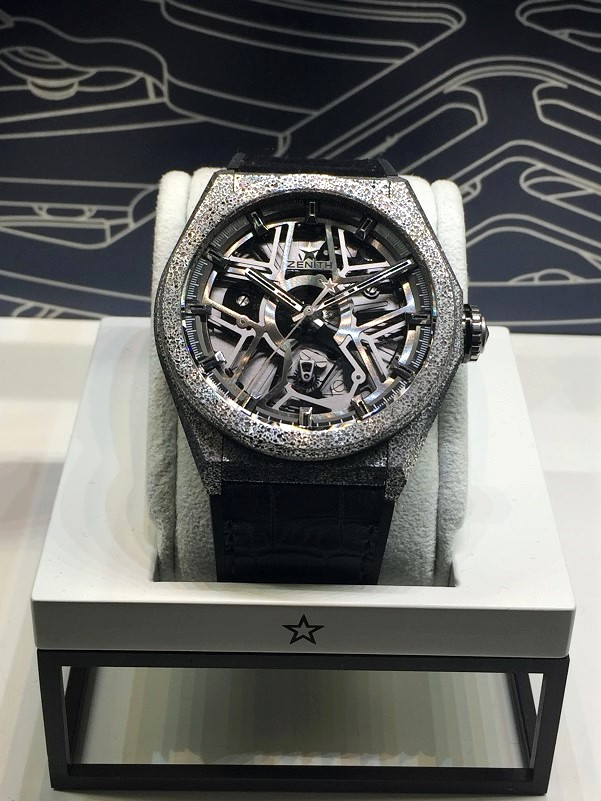
Zenith Defy Inventor with oscillator
WA: You have previously described the luxury watch industry as being in a period of transition. The pandemic has certainly expedited some aspects of change, with brands like Patek Philippe now allowing authorised retailers to sell their watches online. What other areas of the industry do you think are key for manufacturers to consider as part of the industry transition?
JCB: I think what is key is to consider the taste and the needs of the new generation, because the new generation will not be the continuation of the past. For many years, a family with a child, when the father was a teacher it was quite common that the boy or the girl would become a teacher, or when the father was a doctor that the boy or the girl would become a doctor. So, we had kids that were somehow copies of mama and papa, they went to church dressed like an adult, you know with a blazer, a tie – the guy is ten years old, and you put him in a tie! That was our education system, so we had copies of adults.
Now, there is a total disruption. The child, the boys, the girls, are disruptive compared to father and mother so this new generation is bringing us totally new ideas, new concepts, new philosophy, and the challenge for the watch industry will be to adapt to what they need. In the past it was easy because everybody thought that he would need a watch, it was normal to think like that. Today, it can be a little bit absurd to think that you need a watch, maybe you need a smart watch that tells you not what time it is but tells you how healthy you are, what you have to do. So, the timekeeping is secondary, so we will have to invent or think what are these kids; what will they want from us once they are 30 years old, and once they can afford a $5,000 or $10,000 watch. I’m not sure that many brands are thinking that way because when I see the novelties and everything it is a continuation of yesterday, and the continuation of yesterday might not satisfy the customer of tomorrow. That is the challenge.
WA: We’ve seen some brands, I think Roger Dubuis is one, where they have a Young Advisory Committee, a team of employees under 30 to help with strategy and inclusivity. Things like this and reaching out to the youth and millennials is something that is probably going to be key.
JCB: You need more than talking to kids, because the millennial will give you a lot of information, and then you have to translate this information and it is always in the translation that there is the problem. Kids can tell you a lot of things, but you have to translate! That is for me the biggest challenge.
WA: In the last 18 months, we have started to see some fantastic collaboration watches, such as Urwerk and DeBethune for OnlyWatch 2019, and then last year MB&F and Moser, Louis Erard and Vianney Halter, Schwarz Etienne and Kari Voutilainen. What do you think about the idea of collaboration watches and their place in the watch industry?
JCB: I think it’s very interesting to have these collaborations, it’s definitely a must, and it is quite adapted to OnlyWatch. If it is adapted for commercial? But, it is probably limited to those events.
WA: All of the watches I mentioned there, obviously the OnlyWatch was one watch, but the other watches were all limited-edition pieces. It is a delicate balance to find something that represents both brands.
JCB: Yep, it’s difficult, but it’s good to have it for a limited edition, that makes sense. What would also make sense, if a brand would come to me for instance, and say “If you would be at my brand, what would you design for this brand?” When Hennes & Mauritz went to Karl Lagerfeld and asked him to design a collection, Karl Lagerfeld designed a collection for them and it was a huge success, but the collection still looked like a Hennes & Mauritz, it didn’t look like a Chanel, it didn’t look like a Fendi, because Karl Lagerfeld was in a position to adapt himself into Hennes & Mauritz. That’s why he was a genius !
Karl Lagerfeld designed for 30 years for many brands but mainly Fendi and Chanel, but never did we have a Fendi which looked 5% like a Chanel, and never did we have a Chanel which looked 5% like a Fendi. He was always capable to design Fendi collection for Fendi, designed by Karl Lagerfeld. And then he designed Chanel for Chanel, designed by Lagerfeld, but it looked like Chanel. And if you took the name away of Karl Lagerfeld, you would not know that it was designed by him, you would only know that it is a great design because he was always capable to enter into Chanel, and then come out of the eyes of Chanel and enter into Fendi and come out.
That makes sense for watchmakers, to do it with a person that is outside like me – I’m not a designer and I’m not a watchmaker.
WA: We are seeing a rise in interest in independent watchmaking brands, many of whom create watches that are markedly different from other watches available on the market in many different ways. We are also seeing this extend to past collections like the Cartier CPCP watches, where some movements were crafted by the likes of Denis Flageollet and François-Paul Journe earlier in their careers. What do you think is driving this growth in both appreciation and interest in independent watchmaking?
JCB: People are looking more and more for individuality. People are looking more and more for exclusivity. People are looking more and more for unique pieces because people want to be different, and that is a trend which is developing more and more. The more people we have who buy watches, the more people say “I have enough watches and now I want something special that is just for me”, or something that other people don’t have on the wrist. After a certain period, more or less, everybody comes to this type of thinking and therefore they cannot find this individuality any more because when you produce 50, 100 or 500,000 pieces, you cannot make each piece individual for a person and therefore the artisans and the independent people, they have a big big niche that is opening every day, and every day this niche becomes bigger.
So, it’s a natural trend that will re-enforce the more we go on, the more these niches will grow. I see a lot of future for these types of watches where you have a personality, where you have exclusivity, where you have prestige, where you have uniqueness, more or less haute couture when everybody can buy now, prêt-à-porter, ready-made, you want people who want something that is just made for themselves. It’s a natural process that is now accelerating and becoming bigger and bigger, so the independents have a lot of happy days in the future.
WA: I guess this is where microbrands are coming in as well, they’re filling that niche that you talked about. Companies like Baltic and other microbrands…
JCB: Yes, absolutely like Baltic. I have three Baltics!
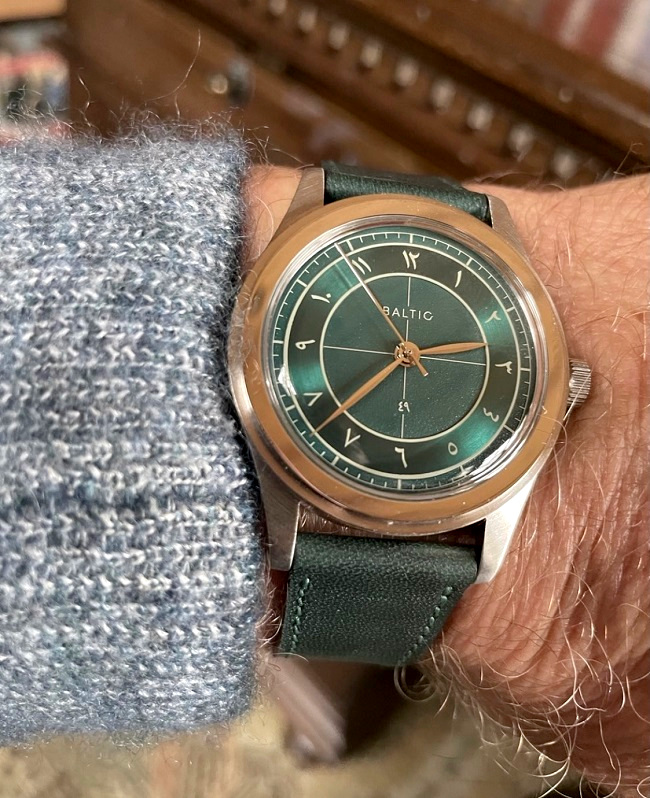
Baltic x Perpétuel HMS, photo – Jean-Claude Biver Instagram @jcbiver
WA: In addition to new brands, we are also seeing new technology enter the industry, such as Blockchain and Non-Fungible Tokens. Blockchain is used by some manufacturers as a more secure proof of ownership and service history, and we are starting to see NFTs with the ‘digital twin’ of your Hublot Bigger Bang, Jacob & Co auctioning a digital only watch that is not a physical piece, and Konstantin Chaykin auctioning an NFT digital artwork inspired by his Joker watches in May. What do you think is the future for blockchain and NFT technology in the luxury watch industry? I think this is a really exciting space!
JCB: It is a really exciting space and there is a huge future. In the future, you will have a virtual watch or virtual piece of art and you will have the three-dimensional piece of art. I could see a brand producing any number, say 50,000 watches that you can wear on your wrist, and selling 50,000 NFT watches. I can even see customers buying both – you have your real watch on your wrist, and you have your NFT watch on your phone. And that’s perfect! And both are blockchain which means both are here for eternity, both will still exist in 150 years. Your mechanical watch piece of art will still exist in 100 years and your virtual NFT will also exist.
I think it is just genius, it’s phenomenal, and the future is eternity, and if the future is eternity you are close to God!
WA: I think it will be very interesting to see when people are more comfortable with a digital asset as opposed to a physical asset, like how the iPad was first created in the 1990s but the world wasn’t ready; I think this technology clearly has an amazing future but maybe when people get more comfortable with the idea of it that’s when it will take off.
JCB: Absolutely! That’s right, and it’s always good to be the first. Be the first even if it has not a lot of success now, what is important is that you are in the train, you are sitting in the train. You don’t know exactly where the train goes, you only know that it leaves the railway station, and you are sitting in the front next to the driver, that’s it, and we can see where we land! It’s like Harry Potter when they go on the train! (laughs)
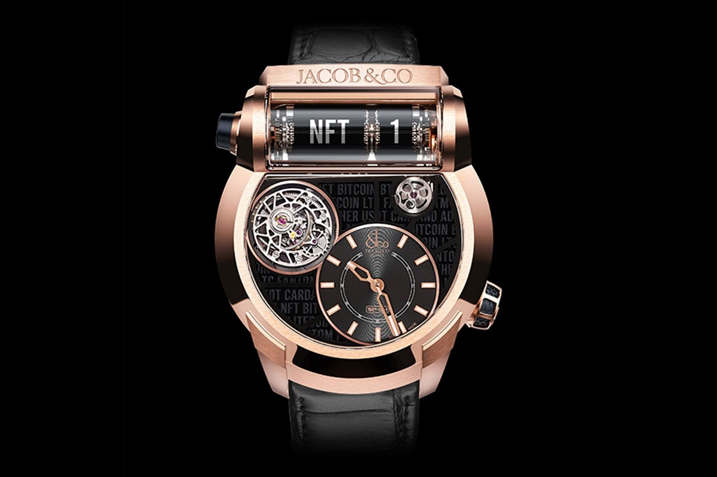
Jacob & Co SF24 NFT Watch, photo – Jacob & Co (the first NFT watch, which sold for US$100,000)
WA: If you could share just one piece of advice you have learned over the course of your career, what would it be?
JCB: I would say that the doubt is your best friend. And never never never try to eliminate the doubt. The doubt wakes me up sometimes at 1 o’clock, 2 o’clock in the night and I have to go to the computer. I have to talk to the doubt, I have to convince it. Our education tells us we should not have doubts, and I say no. The doubt is there, it has a mission. The mission of the doubt is to tell you have you double checked everything.
It’s like checking the plane. I was sitting in my plane which I shared with another friend and we had to fly, first to Zurich, then to Munich, then to Bucharest, and finally to Istanbul for a dinner. Of course, because of the traffic jam, except for Munich we were always late! The last time we took off, the two pilots were reading the checklist and I said, “Can we not leave now? You have been reading this checklist 4 times already!” The captain said to me “If I don’t read this list one day, you jump out of the plane!” (laughs) “We need this checklist because we want to be sure that we do it right.”
And so, the doubt is your checklist and I have learned, let the doubt come in. Let the doubt influence you. Play with the doubt, talk with the doubt, challenge the doubt, but don’t tell it to go. Listen to it, open your eyes, open your ears, and let the doubt come in. And then you can change your mind. Many people said to me “Mr. Biver, I thought you were so strong when you’re making a decision” and I said “No, because I can make a decision and then I can have doubts, and tomorrow I change my decision.” I have no fear to change my decision. I have no fear also to be wrong, because if I am wrong, I’m wrong, and I say to people I am wrong and now we change direction. “No, we go South!” “But you told us we should go North!” “Yes, I told you we should go North but I was wrong! So now we go South, OK guys!”
That is the biggest lesson – let the doubt come in and don’t be afraid to be wrong. Every time you are wrong, just say and tell people “I was wrong” There is nothing wrong in being wrong. We should admit it and just act accordingly and when you think you’re wrong… go, change direction! Don’t be afraid of what people will tell you!
WA: I think that’s a great lesson! So finally, what is next for Jean-Claude Biver?
JCB: That I don’t know! I still have too many doubts (laughs) I haven’t finished my discussion with the doubt, as soon as I have finished my discussions with the doubt, I will tell people what is next! For the moment I’m still in discussion, with my doubt, with my brain and my heart, and both don’t agree. My head tells me, “Don’t do it” and my heart tells me, “Yes, do it! You have a passion, go into your passion full speed!” My head says “Hey guy, you are 72 years old are you crazy! Maybe there are other things you should do!” And I still don’t know.
WA: Still listening to the doubts! I look forward to seeing what you do decide to do when you’ve settled your doubts.
JCB: Yep!
WA: It has been a pleasure to meet you, thank you very much for your time I really do appreciate it!
JCB: Brilliant, thank you!
WA: All the best!
JCB: Ciao ciao, bye!
You can follow Jean-Claude Biver on Instagram here.
A huge thank you to Fred Merz for use of his portrait – you can follow Fred Merz on Instagram here, or visit the Lundi 13 agency here.
Share your thoughts with us via our Contact page, or via our Instagram
Don’t forget to check out the Interviews Page for more!
You might also be interested in:
- Jean-Claude Biver: A Retrospective, Share Respect Forgive
- Recommended Reading: ‘The Wizard of Swiss Watchmaking’ – Interviews with Jean-Claude Biver
- Watch Stationery and Gift Ideas
- Watch Books, Watch Boxes and more at the Watch Affinity Shop on Amazon (commissions earned)
As an Amazon Associate, I earn from qualifying purchases – thank you for your support

